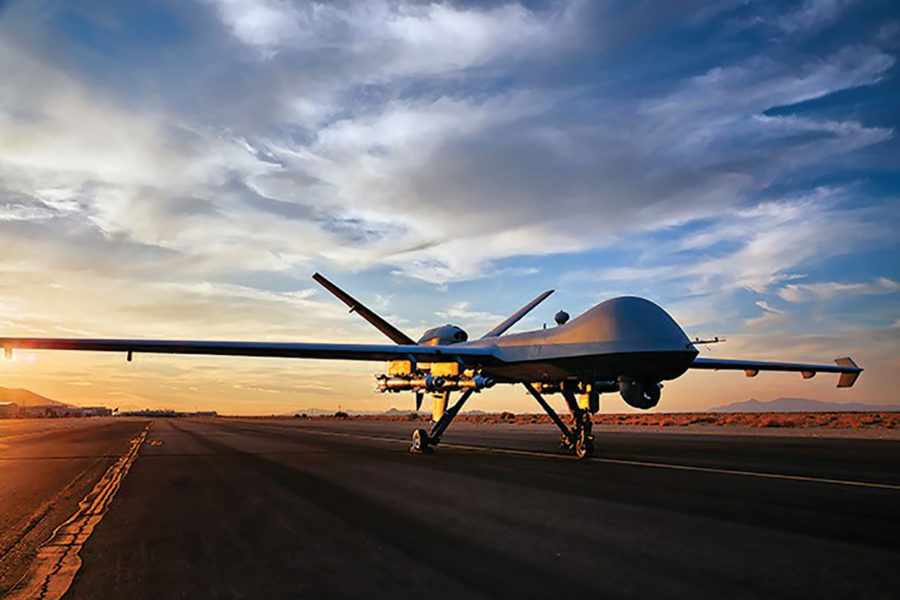The MQ-9B is a medium- to high-altitude, long-endurance hunterkiller RPA, primarily tasked with eliminating time-critical and high-value targets in permissive environments.
Additional roles include CAS, CSAR, precision strike, armed overwatch, target development/designation, and terminal weapon guidance. The MQ-9 fulfills a secondary tactical ISR role utilizing its Multispectral Targeting System-B (MTS-B), upgraded Lynx SAR, and/or Gorgon Stare wide-area surveillance (fielded on seven modified aircraft). MTS-B integrates EO/ IR, color/ monochrome daylight TV, imageintensified TV, and a laser designator/ illuminator. MTS-B provides FMV as separate video streams or fused together.

The MQ-9 employs SAR for JDAM targeting and dismounted target tracking. A Reaper system comprises three aircraft, GCS, LOS/BLOS satellite and terrestrial data links, support equipment/personnel, and crews for deployed 24-hour operations. MQ-9B debuted in combat in Afghanistan in 2007.
The fleet is split between earlier Block 1 and later Block 5 aircraft that are retrofitted to meet operational needs. Extended Range (ER) mods add external fuel tanks, a four-bladed propeller, engine alcohol/water injection, heavyweight landing gear, longer wings and tail surfaces, and other enhancements.
A total of 106 Block 1 aircraft were upgraded to ER standards through 2020, and the Block 5 fleet is currently undergoing mods. General Atomics successfully flew the future MQ-9 Multi-Domain Operations (M2DO) configuration for the first time Nov. 10, 2022. M2DO offers enhanced data link and control robustness, plug-and-play system integration, and double the power to integrate future advanced sensors, systems, and algorithms. M2DO enhancements include anti-jam GPS, Link 16, internet-protocol and modular mission system architecture, enhanced C2 resiliency, and greater flight autonomy/automation. Ongoing mods include ER conversions, DAS-4 high-definition EO/IR sensor, data link, GPS, and Gorgon Stare improvements, reliability mods, and capability enhancements.
The service is transitioning the fleet from counterinsurgency to future roles in or near contested airspace. Reapers demonstrated a maritime support, C2, and ISR role flying from forward operating locations in the Pacific as well as conducting tactical SATCOM Automatic Take-Off and Land Capability (ATLC) operations in 2022. ATLC enables MQ-9 to operate from any airfield in the world without a line-ofsight ground station vastly increasing its flexibility.
USAF plans to retire Block 1s by 2024 followed by the highest-time Block 5 airframes through 2027. Plans call for retaining 140 Reapers through 2035, until a more survivable, flexible, and advanced platform can be fielded. An MQ-9 was lost in a high-profile mid-air collision with a Russian Su-27 following a botched intercept in international airspace over the Black Sea on March 14, 2023.
Contractors: General Atomics Aeronautical Systems; L3Harris; Raytheon (sensors).
First Flight: February 2001.
Delivered: November 2003-present.
IOC: October 2007; 2015 (ER).
Production: 337 (planned).
Inventory: 289.
Operator: ACC, AFMC, AFRC (associate), AFSOC, ANG.
Aircraft Location: Cannon AFB, N.M.; Creech AFB, Nev.; Eglin AFB, Fla.; Ellington Field, Texas; Fort Drum, N.Y.; Fort Huachuca, Ariz.; Hancock Field, N.Y.; Hector Arpt., N.D.; Holloman AFB, N.M.; March ARB, Calif.; Nellis AFB, Nev., and deployed locations worldwide. Planned: Tyndall AFB, Fla.; Whiteman AFB, Mo.
GCS Location: Cannon AFB, N.M.; Creech AFB, Nev.; Battle Creek ANGB, Mich.; Davis-Monthan AFB, Ariz.; Des Moines Arpt., Iowa; Ellington Field, Texas; Ellsworth AFB, S.D.; Fort Smith Arpt., Ark.; Hancock Field, N.Y.; Hector Arpt., N.D.; Holloman AFB, N.M.; Horsham AGS, Pa.; Hurlburt Field, Fla.; March ARB, Calif.; Springfield-Beckley Arpt., Ohio. Planned: Niagara Falls Arpt., N.Y.; Shaw AFB, S.C.; Tyndall AFB, Fla.; Whiteman AFB, Mo.
Active Variants: •MQ-9B Reaper Block 1. Air Force version of the General Atomics Predator B. •MQ-9B Reaper Block 5. Improved, current production Reaper. •MQ-9B Reaper ER. Extended-range MQ-9 with external fuel tanks, longer wings, and other enhancements.
Dimensions: Span 66 ft (79 ft, ER), length 36 ft, height 12.5 ft.
Weight: Max T-O 10,500 lb.
Power Plant: One Honeywell TPE331-10GD turboprop, max 900 shp.
Performance: Cruise speed 230 mph, range 1,150 miles, endurance 27 hr; 34 hr (ER).
Ceiling: 50,000 ft.
Armament: Combination of AGM-114 Hellfire (up to eight), GBU-12/49 Paveway II, and GBU-38 JDAMs.
Accommodation : Pilot, sensor operator (operating from GCS).


